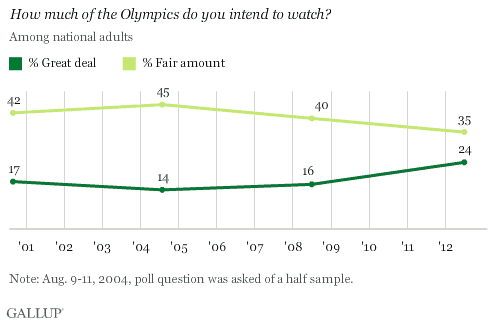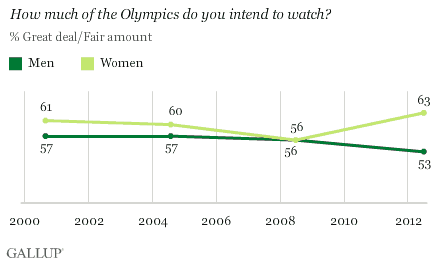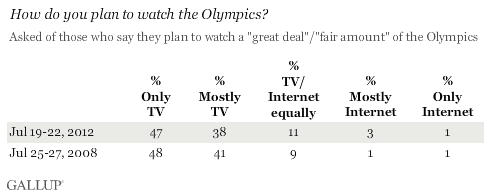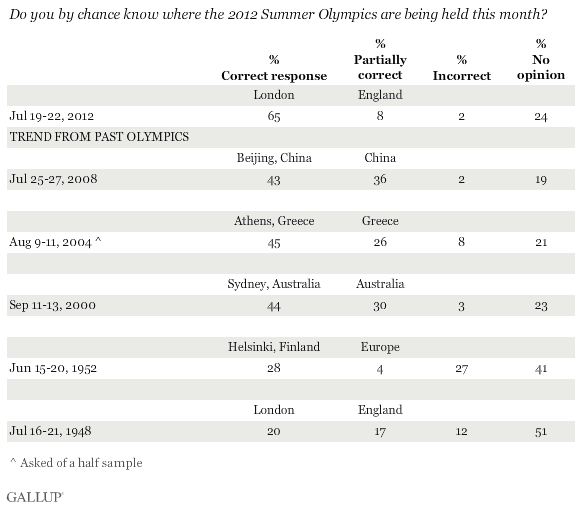WASHINGTON, D.C. -- Fifty-nine percent of Americans say they plan to watch a "great deal" or "fair amount" of the 2012 Summer Olympics, similar to the percentage for the past three Summer Olympics. However, the 24% who plan to watch "a great deal" is higher than in past years.

Twenty-eight percent plan to watch "not much" of the Olympics, while 13% say they will watch "none at all."
Gallup asked Americans about their Olympics-watching plans in a July 19-22 survey, ahead of the summer 2012 games, which kick off Friday night in London. Gallup asked the same question in advance of the 2000, 2004, and 2008 Summer Olympics.
Women More Likely Than Men to Say They Plan to Watch
Even though a 2009 Gallup poll found that men are more likely than women to be sports fans, in the current poll, women (63%) are more likely than men (53%) to say they plan to watch a great deal or fair amount of the Olympics. Women and men were about equally likely to plan to watch at least a fair amount in 2000, 2004, and 2008. Plans for watching the Olympics do not vary much among different subgroups of Americans beyond gender.

TV Still Dominates as Olympic Watchers' Viewing Platform of Choice
The overwhelming majority (85%) of those who plan to watch the Olympics say they will do so "only" (47%) or "mostly" (38%) on television. Only 4% of Americans who plan to watch say they will do so only or mostly via the Internet, even though all events, including less-popular sports and events involving other countries, will be live streamed online for the first time ever.

Americans may already be less likely to watch the less popular sports and competition between other countries. They may also prefer the commentary on television, the ease of watching with family and friends on the larger television screen, and the convenient television times.
Despite the rise in Internet coverage, as well as the rise of portable viewing devices such as tablets and smartphones since the last Olympics, the percentage who plan to watch on TV vs. via the Internet has changed little since 2008.
Awareness About Where Olympics Are Being Held Is Up From Past
More Americans are able to identify the city where the Olympics are taking place this year than have done so in the past. In the summers of five past Olympic years, Gallup has asked Americans if they knew where that year's summer games were being held. This year, 65% of Americans correctly identified London, with an additional 8% identifying England as the location. For the previous three Summer Olympics, fewer than half could identify the host city.
The combined 73% correctly identifying the city or country of the Olympics is similar to what Gallup found in 2000-2008. However, it is much higher than in 1952 (32%) and 1948 (37%), during the early days of television. The 1948 Olympics were also held in London, with 20% at that time correctly identifying the host city and 17% the host country.

Implications
With nearly six out of 10 Americans planning to watch a great deal or fair amount of the 2012 Summer Olympics, Americans' attention may be diverted from the divisive presidential campaign to something that tends to bring Americans together. Despite the rise in technological advances that make live viewing of Olympic events possible, Americans still prefer to watch on television rather than on a computer, tablet, or smartphone. This is the case even though there is a five-hour time difference between London and the U.S. East Coast, suggesting that larger screens, force of habit, or daily schedules are stronger considerations than immediacy when it comes to how Americans will view the Olympics.
Survey Methods
Results for this Gallup poll are based on telephone interviews conducted July 19-22, 2012, with a random sample of 1,030 adults, aged 18 and older, living in all 50 U.S. states and the District of Columbia.
For results based on the total sample of national adults, one can say with 95% confidence that the maximum margin of sampling error is ±4 percentage points.
For results based on the total sample of 624 national adults who plan to watch the Olympics, one can say with 95% confidence that the maximum margin of sampling error is ±5 percentage points.
Interviews are conducted with respondents on landline telephones and cellular phones, with interviews conducted in Spanish for respondents who are primarily Spanish-speaking. Each sample includes a minimum quota of 400 cell phone respondents and 600 landline respondents per 1,000 national adults, with additional minimum quotas among landline respondents by region. Landline telephone numbers are chosen at random among listed telephone numbers. Cell phone numbers are selected using random-digit-dial methods. Landline respondents are chosen at random within each household on the basis of which member had the most recent birthday.
Samples are weighted by gender, age, race, Hispanic ethnicity, education, region, adults in the household, and phone status (cell phone only/landline only/both, cell phone mostly, and having an unlisted landline number). Demographic weighting targets are based on the March 2011 Current Population Survey figures for the aged 18 and older non-institutionalized population living in U.S. telephone households. All reported margins of sampling error include the computed design effects for weighting and sample design.
In addition to sampling error, question wording and practical difficulties in conducting surveys can introduce error or bias into the findings of public opinion polls.
View methodology, full question results, and trend data.
For more details on Gallup's polling methodology, visit www.gallup.com.
